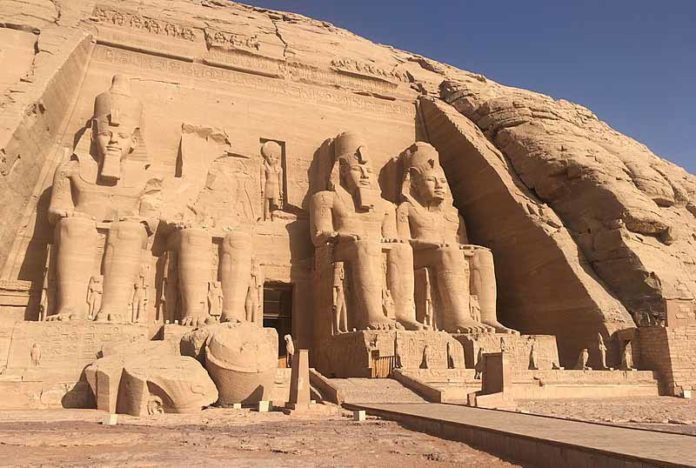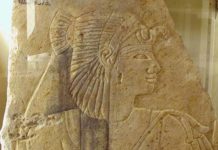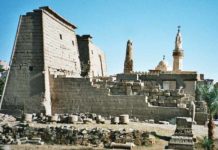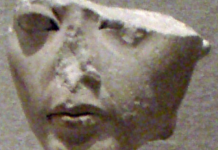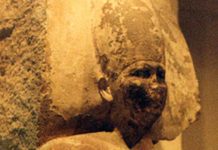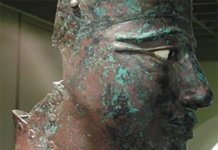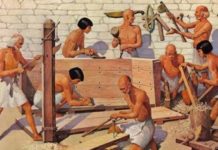Located on the west bank of the Nile south of Aswan, in what used to be Nubia, the temples of Abu Simbel were completely carved out of sandstone cliffs. Since then they have inspired awe in everyone who has come across them.
Abu Simbel Construction
The construction of Abu Simbel began around 1244 BC and was completed 20 years later in1224 BC. The Temple of Ramesses, beloved of Amun, the larger temple on the site, has one sanctuary and several chambers carved into the cliff side, each growing shorter than the last, as was the tradition in ancient Egyptian temple building. The cliff face was carved back to resemble a pylon and was adorned with four large statues of Ramesses each standing 67 feet tall. The Temple of Nefertari was built very similarly, however, the smaller temple only has one sanctuary with two side chambers. Th facade of the great temple measures 120 feet wide by 100 feet tall and Nefertari’s facade is 80 feet wide.
Design Details of Abu Simbel
Ramesses’ Temple pominently features four large collosi of the pharaoh himself (one of which was later damaged by an earthquake). Each large statue is flanked by smaller statues of the royal family including Queen Nefertari, Queen Mut-Tuy, and his children, Princes Amun-her-khepeshef and Ramesses and Princesses Bintanath, Baketmut, Nofertari, Neritamen, Nebettawy and Isetnofret. The facade was topped by 22 baboons, Watchers of the Dawn, which were linked to Ra and sacred to the worship of the rising sun. Also on the outside of the temple is a stele that tells of the marriage of Ramesses to the daughter of King Hattusili III of the Hittites, an event which sealed the peace between the two nations. Inside the main chamber of the temple are eight pillars carved as the god Osiris. Throughout the temple are reliefs of the Battle of Kadesh and other miltary victories in Lybia and Nubia as well as depictions of offerings to Amun Ra of Thebes, Ptah of Memphis ad Ra-Horakhty of Heliopolis. In the inner shrine of the temple are four seated statues of these three gods along with Ramesses in his deified form.
The facade of the Temple of Nefertari (also called the Temple of Hathor) contains six large statues, four of Ramesses and two of Nefertari, and also contains smaller statues of their children, princes Meryatum Meryre, Rahirwenemef and Amun-her-khepeshef and the princesses Meritamen and Henuttawy. However, the temple’s facade was unique in that it is the only time in ancient Egypt when the queen was depicted as being the same size as the pharaoh (usually they were never taller than his knees) which indicates tha Ramesses thought of Nefertari as his equal. Inside the temple are reliefs of both Ramesses and Nefertari honoring and being honored by Hathor, Horus, Khnum, Khonsu, Thoth, Isis, Maat, Mut of Asher, Satis and Taweret.
Abu Simbel’s Purpose
One of six temples erected in Nubia by Ramesses II, Abu Simbel was built to impress th Nubians with the pharaoh’s greatness and to reinforce the importance of the Egyptian religion. The temple complex was oriented so that on February 22 and October 22 (the pharaoh’s birthday and the anniversary of his coronation) the light of the rising sun enters the temple and lights the statue of Ramesses in the inner sanctuary. During the pharaoh’s lifetime, each temple had a priest (although the king was theoretically the only person allowed to perform religious ceremonies at the temple) who was educated in reading, writing, engineering, arithmetic, geometry, astronomy, space measurement and time calculations.
The Rediscovery of Abu Simbel
Over time the desert sands covered the temple complex and it was eventually forgotten. In 1813, Swiss orientalist J.L. Burckhardt found the top of the frieze. Later he returned with Italian explorer Giovanni Belzoni, but they were unable to dig out an entrance to the temple. Four years after the original discovery, Belzoni returned and managed to enter the temple. Anything that was valuable and portable was removed from the site and sold to European collectors, museums and governments. According to local legends, the complex was named after a young boy who guided Burckhardt and Belzoni to the site of the temple.


